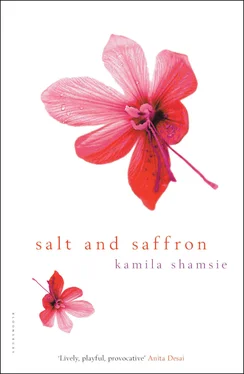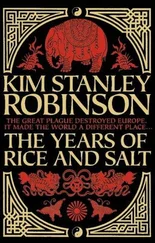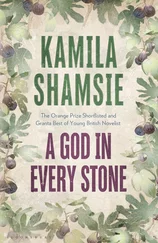Still, given our family’s belief that it was the not-quites alone who prevented us from replacing the Mughals, Rehana Apa was kind to point out the obvious: those sad, sad eyes of an emperor deposed could have been Dard-e-Dil eyes. So perhaps, in the case of Ibrahim and Zain, the not-quites indirectly brought about a blessing. That’s what Rehana Apa was trying to say; but, of course, taking the throne of the Mughals would not have meant replicating the actions — and the downfall — of the Mughals. I know what prevented us from being deposed, and worse, after the débâcle of 1857. It was not the fact that we didn’t sit on the throne of Delhi. It was all down to Taj’s mother. Yes, the woman whom Dadi had compared to Leda.
All right, let me clarify. Skipping ahead over three hundred years from the days of Babur, let’s consider what happened to the Dard-e-Dils during the Revolt or Mutiny or War of Independence, or whatever your preferred name for the events of 1857. Near the start of the fighting, when Bahadur Shah Zafar, last Emperor of the Mughals, found himself whisked away from his poetry and music to become the figurehead around which the Rebels banded, the then Nawab of Dard-e-Dil sent his heir apparent to meet the Emperor’s representatives and assure them of Dard-e-Dil support. The heir apparent dawdled. Not because he thought joining the Revolt was a bad idea, but because he was lazy, dedicated to pleasure, and saw no reason to be galloping around the country like an ordinary messenger. He feared if he proved too efficient his father would make a habit of sending him off on such expeditions. He couldn’t dawdle around the palace, of course, because his father’s spies were everywhere. So he rode into the fields around Dard-e-Dil instead, where he saw Taj’s mother who looked him in the eye.
Why do we know this and nothing else, except what we can naturally assume given Taj’s birth, nine months later? Her elbows were not tantalizing, but she looked him in the eye. That’s the one line the family devotes to Taj’s mother, the woman without name. Did she look him in the eye to let him know she thought him worth looking at? Or to show she was no bowing and scraping royalist? Or to clarify that he was not worth a bow or a scrape? Did he find her gaze attractive? Offensive? Diverting?
She died in childbirth, so even her daughter could do nothing more than speculate. But the Dard-e-Dils don’t speculate, because motives and emotions aren’t pertinent. What is pertinent is that Taj’s mother delayed the prince, giving the Nawab’s chief messenger those few extra seconds needed to intercept him just before he extended a hand of support to the Revolt. The Nawab had dithered after his son rode away. Unable to decide whether to back Bahadur Shah or the British, he told his messenger, ‘Leave now. If you reach my son before he delivers a promise of assistance, then tell him to return at once. If he has made the promise, tell him we will stand by it.’ Taj’s mother looked straight at the prince, slowed his progress by … minutes … seconds, and thus we were spared the hangings, the stripping away of titles and possessions, the sad, sad eyes.
I know the prince’s name, but I will not mention it. This gesture is meaningless in the grand scale of things, but sometimes we need to be less than grand.
We were all too grand in the most petty of ways towards Taj. Her mother saved our family, in a manner of speaking, and even if she hadn’t … even if she hadn’t …
Taj’s mother gave birth near the entrance to the palace ground. Then died. It must have been those days of standing in the sun, waiting for the prince or the Nawab to allow her an audience, that sapped from her all energy except that needed to give her daughter life. Her family took Taj away, raised her, and kept her far, far away from the palace.
Such tales are common amongst royal families. But not ours. Taj’s mother is an exception and that’s what makes me think that Dadi was probably right when she said that Taj’s mother, and later Taj, came to symbolize that fateful decision to turn away from the Revolt. It was a decision that saved the Dard-e-Dil family, but we were too ashamed to rejoice. From the roof of the Dard-e-Dil palace you could see trees in neighbouring states from which the Rebels were hanged. And not just the Rebels. What was the name of that Englishman who, in the wake of 1857, said he wanted to see a Muslim hanging from every tree in India? Better he remain nameless, too.
There was one tree in particular which the Dard-e-Dil royals could not bear to look at — the tree from which the Nawab’s fourth cousin, ruler of a neighbouring state and participant in the Revolt, had been hanged. In Dard-e-Dil you could hear the creaking rope as his body swayed in the breeze. So the story goes. The British hanged all his heirs, too, of course, and annexed his lands. A portion of the lands was given to the Dard-e-Dils in recognition of their loyalty. It was a small portion, far less than that doled out to many of the royals who stayed out of the fray. That seems confirmation enough that the British knew how close we came to switching our allegiances, and wished us to always have a subtle reminder of what happened to the lands and lives of errant princes. And, now that I think of it, couldn’t they have hanged him from another tree, one less visible from miles away in a north-westerly direction?
No surprise then that we wanted no further reminders of that message intercepted and reversed. So we shunned Taj’s mother and we shunned Taj. Until the unnamable prince, who was by now a bare-handed killer of tigers, became Nawab and his wives bore him no children who survived the trauma of birth. As a last resort, one of his courtiers told him of a peasant girl, only fifteen, who was already skilled in midwifery. The Nawab called for her, and when she looked him in the eye with eyes that were his eyes he knew his children would live only if she delivered them and received royal favours for doing so.
For forty-eight years Taj delivered Dard-e-Dils. Delivered her brothers and sisters, her cousins, her nephews and nieces, her great-nephews and great-nieces. Received gold and umbilical cords in return. What did she do with the cords? She took them, that’s all. More to the point, in taking the cords she gave the Dard-e-Dils something her mother had never given them: a reason to remember her name. And then the three boys were born near midnight. At what times exactly? Only Taj knows, and maybe even she didn’t. Of course she left the palace immediately after that. She’d delivered them, announced the timings of their births, taken their umbilical cords. Without a doubt, no question of it, she’d secured a place in the family story.
I looked at the picture that Rehana Apa had sent with her letter. Dadi and the three boys, laughing in the palace grounds. If they knew they were fated to bring misery to the family you wouldn’t know it by looking at the photograph.
I showed Dadi the photograph that evening. She rested it on her lap and hung her head low. I waited for her to look up and when she didn’t I walked over to her and placed my hands over two of the brothers so that all that remained visible was Dadi angling her body towards the boy in the centre.
‘That’s the most romantic picture of you and Dada I’ve ever seen,’ I said.
‘That’s not your grandfather. It’s Taimur.’
She wouldn’t say any more about it, and no matter what I said the rest of the evening I couldn’t make her laugh.
‘Aliya, sweetoo, you must come over right away. Futafut. On the double take.’ It was Older Starch on the phone, disrupting my evening cup of tea with Sameer.
‘I would have loved to, but Sameer’s over.’
Читать дальше












